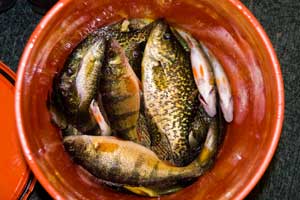(Provided by Michigan DNR)
 Fletcher Floodwaters Cranks Out Panfish, Pike and BassFletcher Floodwaters is a beautiful lake in Alpena County that Tim Cwalinski, DNR fisheries biologist out of Gaylord, refers to as "a monster.
Fletcher Floodwaters Cranks Out Panfish, Pike and BassFletcher Floodwaters is a beautiful lake in Alpena County that Tim Cwalinski, DNR fisheries biologist out of Gaylord, refers to as "a monster.
"It's one of the biggest lakes in the state at 8,800 acres," he explains.
Fletcher's is an impounded reach of the Upper South Branch Thunder Bay River and, despite its size, is actually pretty shallow. As a result, it's often one of the first large lakes to freeze and bring with it excellent ice fishing.
Anglers traditionally target panfish (including bluegill, pumpkinseed, yellow perch and black crappie), northern pike and largemouth bass there and Cwalinski believes it sees more fishing pressure than any other lake in the DNRs Northern Lake Huron Maagement Unit.
While heavy in numbers, the panfish found in Fletcher Floodwaters tend to be moderate in size, with few growing into the trophy category. The lake offers abundant spawning and hiding areas which results in a higher survival rate of these species.
According to Cwalinski, northern pike fishing probably comes second in popularity to those targeting panfish - with opportunities to do so presenting themselves throughout the winter, spring and fall. There is a spearing ban for pike on Fletcher Floodwaters, one that has been in place for many decades and highly supported by the local resort owners.
"Due to the shallow nature, there is no cold water in Fletcher's in the summer," said Cwalinski. "Pike activity and growth goes to almost nothing in the summer so you probably see more pike growth in the winter than in the summer - which isn't typical in Michigan."
He went on to explain the history of northern pike growth at Fletcher Floodwaters has changed significantly over time, say during the last 60 to 70 years. At one time, the lake was dominated by a very large population of small pike, with little else to fish for. Over the years the DNR kept liberalizing pike harvest due to their consistent stunting and today the pike population, and the fish community as a whole, has changed for the better.
"Today there are less pike in Fletcher Floodwaters than a half century ago, but their growth rates are so much better," Cwalinski said. "Now it's not uncommon to see a 24 to 34-inch pike in there."
In addition to excellent panfish and pike fishing, Fletcher Floodwaters has exploded for largemouth bass fishing in the last 10 to 20 years. It's quickly becoming a destination for serious bass anglers; although Cwalinski points out that the more prominent bass tournaments don't typically fish there because the lake is full of timber and weeds, and often scare bass tournament anglers with prized fishing boats.
"You also won't see any other type of water recreation going on at Fletcher's, like jet skis or speed boats," he explained. "It's a really great spot for people who just want to fish and there are tons of places to stay - whether you want to rent a cabin or camp."
Although Cwalinski doesn't personally fish there often, he's quick to point out that if he did he would focus on fishing first and last ice.
"Last ice - usually getting into March - is usually the best fishing, if you can get out there and brave some sloppy conditions," he said. "There seems to be an overabundance of weeds - which translates to more food types becoming active and that really turns the fish on."
It should be noted that because of the shallow nature of this lake, localized partial winter kills occur regularly. It's not uncommon to see 5,000 to 10,000 dead fish, which - although visually jarring - is not typically unhealthy for this lake, as it helps to reduce population density and competition.